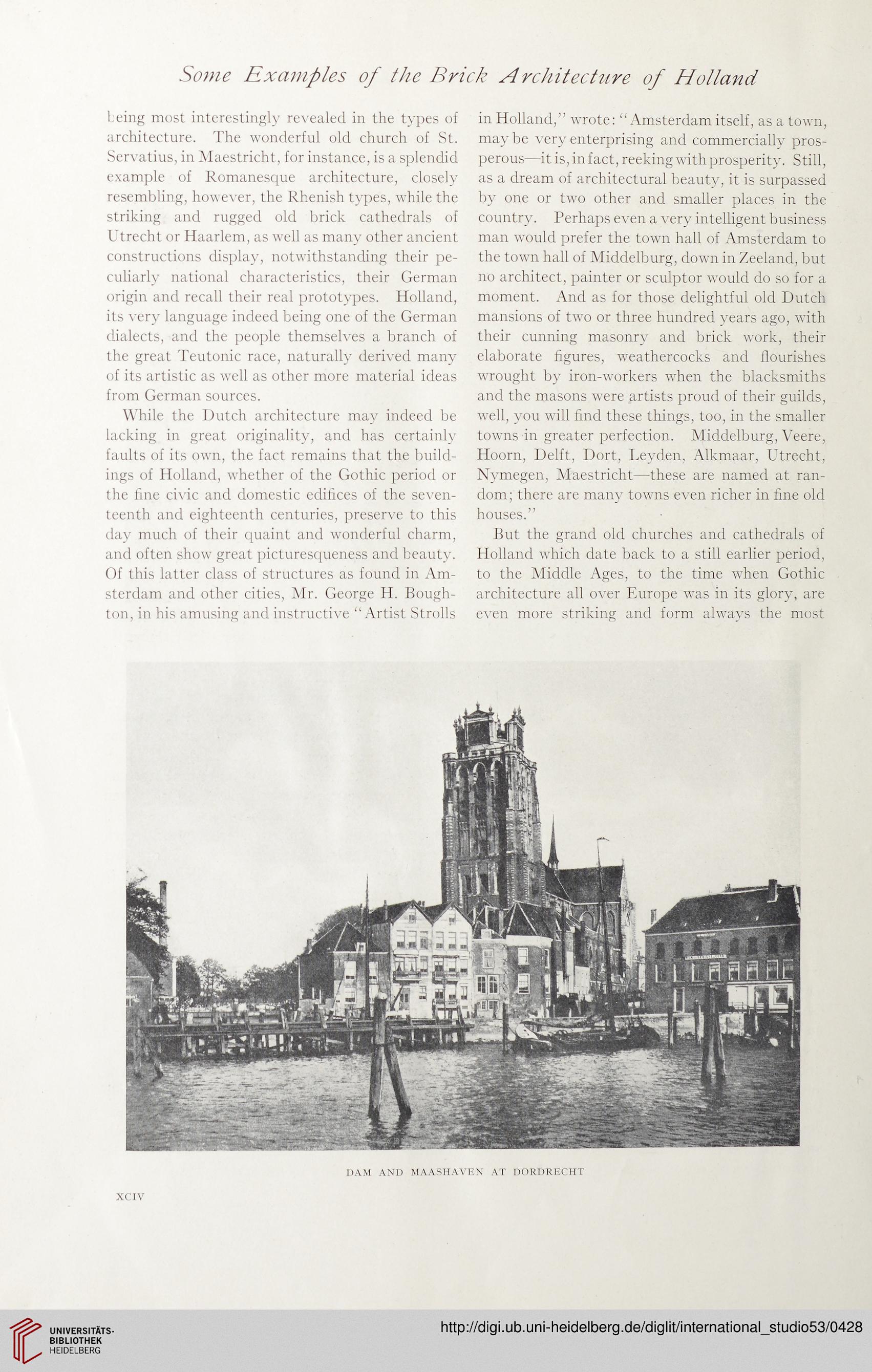Some Examples of the Brick Architecture of Holland
being most interestingly revealed in the types of
architecture. The wonderful old church of St.
Servatius, in Maestricht, for instance, is a splendid
example of Romanesque architecture, closely
resembling, however, the Rhenish types, while the
striking and rugged old brick cathedrals of
Utrecht or Haarlem, as well as many other ancient
constructions display, notwithstanding their pe-
culiarly national characteristics, their German
origin and recall their real prototypes. Holland,
its very language indeed being one of the German
dialects, and the people themselves a branch of
the great Teutonic race, naturally derived many
of its artistic as well as other more material ideas
from German sources.
While the Dutch architecture may indeed be
lacking in great originality, and has certainly
faults of its own, the fact remains that the build-
ings of Holland, whether of the Gothic period or
the fine civic and domestic edifices of the seven-
teenth and eighteenth centuries, preserve to this
day much of their quaint and wonderful charm,
and often show great picturesqueness and beauty.
Of this latter class of structures as found in Am-
sterdam and other cities, Mr. George H. Bough-
ton, in his amusing and instructive “Artist Strolls
in Holland,” wrote: “Amsterdam itself, as a town,
may be very enterprising and commercially pros-
perous—it is, in fact, reeking with prosperity. Still,
as a dream of architectural beauty, it is surpassed
by one or two other and smaller places in the
country. Perhaps even a very intelligent business
man would prefer the town hall of Amsterdam to
the town hall of Middelburg, down in Zeeland, but
no architect, painter or sculptor would do so for a
moment. And as for those delightful old Dutch
mansions of two or three hundred years ago, with
their cunning masonry and brick work, their
elaborate figures, weathercocks and flourishes
wrought by iron-workers when the blacksmiths
and the masons were artists proud of their guilds,
well, you will find these things, too, in the smaller
towns in greater perfection. Middelburg, Veere,
Hoorn, Delft, Dort, Leyden. Alkmaar, Utrecht,
Nvmegen, Maestricht—these are named at ran-
dom; there are many towns even richer in fine old
houses.”
But the grand old churches and cathedrals of
Holland which date back to a still earlier period,
to the Middle Ages, to the time when Gothic
architecture all over Europe was in its glory, are
even more striking and form always the most
DAM AND MAASHAVEN AT DORDRECHT
XCIV
being most interestingly revealed in the types of
architecture. The wonderful old church of St.
Servatius, in Maestricht, for instance, is a splendid
example of Romanesque architecture, closely
resembling, however, the Rhenish types, while the
striking and rugged old brick cathedrals of
Utrecht or Haarlem, as well as many other ancient
constructions display, notwithstanding their pe-
culiarly national characteristics, their German
origin and recall their real prototypes. Holland,
its very language indeed being one of the German
dialects, and the people themselves a branch of
the great Teutonic race, naturally derived many
of its artistic as well as other more material ideas
from German sources.
While the Dutch architecture may indeed be
lacking in great originality, and has certainly
faults of its own, the fact remains that the build-
ings of Holland, whether of the Gothic period or
the fine civic and domestic edifices of the seven-
teenth and eighteenth centuries, preserve to this
day much of their quaint and wonderful charm,
and often show great picturesqueness and beauty.
Of this latter class of structures as found in Am-
sterdam and other cities, Mr. George H. Bough-
ton, in his amusing and instructive “Artist Strolls
in Holland,” wrote: “Amsterdam itself, as a town,
may be very enterprising and commercially pros-
perous—it is, in fact, reeking with prosperity. Still,
as a dream of architectural beauty, it is surpassed
by one or two other and smaller places in the
country. Perhaps even a very intelligent business
man would prefer the town hall of Amsterdam to
the town hall of Middelburg, down in Zeeland, but
no architect, painter or sculptor would do so for a
moment. And as for those delightful old Dutch
mansions of two or three hundred years ago, with
their cunning masonry and brick work, their
elaborate figures, weathercocks and flourishes
wrought by iron-workers when the blacksmiths
and the masons were artists proud of their guilds,
well, you will find these things, too, in the smaller
towns in greater perfection. Middelburg, Veere,
Hoorn, Delft, Dort, Leyden. Alkmaar, Utrecht,
Nvmegen, Maestricht—these are named at ran-
dom; there are many towns even richer in fine old
houses.”
But the grand old churches and cathedrals of
Holland which date back to a still earlier period,
to the Middle Ages, to the time when Gothic
architecture all over Europe was in its glory, are
even more striking and form always the most
DAM AND MAASHAVEN AT DORDRECHT
XCIV




